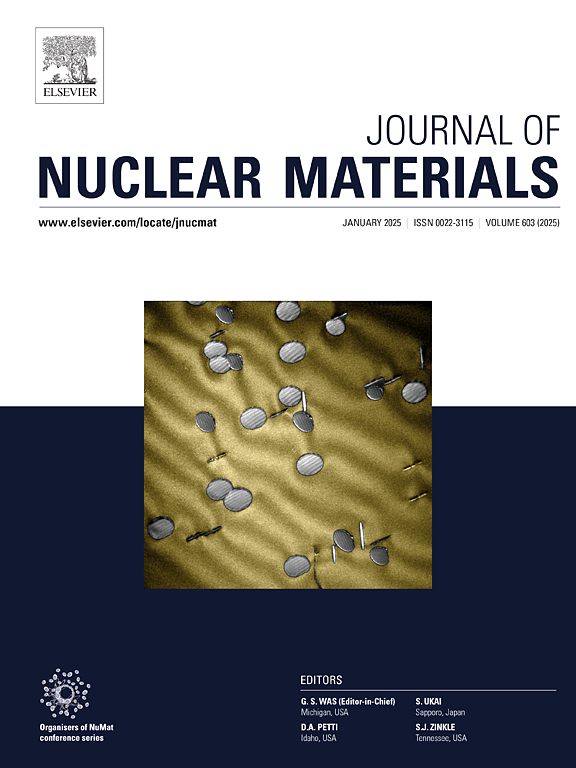Study of the corrosion behaviour of beryllium in solutions representative of Portland cement and magnesium phosphate cement
IF 2.8
2区 工程技术
Q3 MATERIALS SCIENCE, MULTIDISCIPLINARY
引用次数: 0
Abstract
Metallic beryllium is an attractive material for nuclear applications, e.g. thermal reactor and fusion reactors. After use, activated beryllium waste will need to be disposed of in a geological disposal repository. One option for the treatment and conditioning of the beryllium waste could be the direct emplacement of pieces of beryllium in a cementitious matrix. In these conditions, beryllium corrodes due to reaction with water to produce hydrogen, and beryllium hydroxide, leading to possible loss of the waste containment. To gain more information on the anaerobic corrosion of beryllium, Electrochemical Impedance Spectroscopy and hydrogen measurement by gas chromatography were used, while beryllium samples were immersed in solutions representative of promising matrices (Portland cement (OPC, pH 13.5) and magnesium phosphate cement (MPC, pH 8.1)) for maximum one year. At the beginning of the test (< 180 days), both techniques showed that the beryllium corrosion rate was lower in OPC solution than in MPC solution. At longer term (> 180 days), the corrosion rate decreased sharply in MPC solution, while the corrosion rate in OPC solution remained stable. Therefore, at longer term, the lower corrosion rate was observed in MPC solution. The reason of this corrosion rate decrease comes from the formation of a passive layer composed of Be(OH)2 (inner part) and KBePO4·H2O crystals (outer part) at the surface of beryllium in MPC solution, while no protective corrosion product layer was present on the metal surface in OPC solution. In that later case, pitting corrosion was observed in addition to the dissolution of beryllium species in solution probably in the form of Be(OH)42−.
铍在硅酸盐水泥和磷酸镁水泥中腐蚀行为的研究
金属铍是一种有吸引力的核应用材料,例如热反应堆和聚变反应堆。使用后,活性铍废物将需要在地质处置库中处置。处理和调理铍废物的一种选择可能是在胶凝基质中直接放置铍片。在这些条件下,铍由于与水反应产生氢和氢氧化铍而被腐蚀,从而可能导致废物容器的损失。为了获得更多关于铍的厌氧腐蚀的信息,使用了电化学阻抗谱和气相色谱法测量氢,同时将铍样品浸泡在代表有前途的基质(波特兰水泥(OPC, pH值13.5)和磷酸镁水泥(MPC, pH值8.1))的溶液中最多一年。在测试开始时(<;两种方法均表明,在OPC溶液中铍的腐蚀速率比在MPC溶液中低。长期来看(>;180 d),在MPC溶液中腐蚀速率急剧下降,而在OPC溶液中腐蚀速率保持稳定。因此,从长期来看,MPC溶液中的腐蚀速率较低。腐蚀速率下降的原因是在MPC溶液中铍表面形成了由Be(OH)2(内部)和KBePO4·H2O晶体(外部)组成的钝化层,而在OPC溶液中金属表面没有形成保护性腐蚀产物层。在后一种情况下,除了可能以Be(OH)42−的形式在溶液中溶解铍外,还观察到点蚀。
本文章由计算机程序翻译,如有差异,请以英文原文为准。
求助全文
约1分钟内获得全文
求助全文
来源期刊

Journal of Nuclear Materials
工程技术-材料科学:综合
CiteScore
5.70
自引率
25.80%
发文量
601
审稿时长
63 days
期刊介绍:
The Journal of Nuclear Materials publishes high quality papers in materials research for nuclear applications, primarily fission reactors, fusion reactors, and similar environments including radiation areas of charged particle accelerators. Both original research and critical review papers covering experimental, theoretical, and computational aspects of either fundamental or applied nature are welcome.
The breadth of the field is such that a wide range of processes and properties in the field of materials science and engineering is of interest to the readership, spanning atom-scale processes, microstructures, thermodynamics, mechanical properties, physical properties, and corrosion, for example.
Topics covered by JNM
Fission reactor materials, including fuels, cladding, core structures, pressure vessels, coolant interactions with materials, moderator and control components, fission product behavior.
Materials aspects of the entire fuel cycle.
Materials aspects of the actinides and their compounds.
Performance of nuclear waste materials; materials aspects of the immobilization of wastes.
Fusion reactor materials, including first walls, blankets, insulators and magnets.
Neutron and charged particle radiation effects in materials, including defects, transmutations, microstructures, phase changes and macroscopic properties.
Interaction of plasmas, ion beams, electron beams and electromagnetic radiation with materials relevant to nuclear systems.
 求助内容:
求助内容: 应助结果提醒方式:
应助结果提醒方式:


